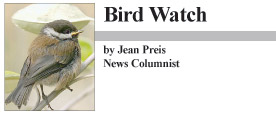Nestlings
 Throughout the spring, the oaks, maples, alders, and birches between our house and the lake have been filling out with leaves, dramatically altering the view from our big window. In winter, the lake was a broad expanse of white ice, and after ice-out we saw an expanse of blue water. Now from our window, we peek out at the lake through the gaps between the leaves, causing us to switch the focus of our early morning nature watching from the lake to our backyard.
Throughout the spring, the oaks, maples, alders, and birches between our house and the lake have been filling out with leaves, dramatically altering the view from our big window. In winter, the lake was a broad expanse of white ice, and after ice-out we saw an expanse of blue water. Now from our window, we peek out at the lake through the gaps between the leaves, causing us to switch the focus of our early morning nature watching from the lake to our backyard.
Most mornings are routine. Goldfinches flock around the seed feeder. The mourning dove flies up in panic over some invisible threat. Phoebe perches on a branch, wags his tail, and occasionally flies out to snap up a tasty insect in the air. Catbirds nest in the thick tangle of wild rose bushes in the middle of the yard, and we enjoy watching them go back and forth to their well-hidden nest. Early risers, they awaken us at 4 a.m. with their complicated jumble of songs that often mimic the sounds of other birds.
This morning, we were sipping our tea by the big window, and nibbling yummy homemade cinnamon toast from the Farmers’ Market, when we noticed something unusual: one of the wild rose bushes was swaying. When little birds fly in and out of those bushes they do it quickly, hardly disturbing a leaf to avoid drawing attention to themselves. The swaying bush hinted that a larger creature had invaded that protected spot. We had seen something yesterday that gave us an idea whom it might be.
Yesterday morning, we had seen a fairly large bird glide across the yard and land on the oak tree. A few seconds later, it glided out of the oak and down into the dense tangle of rose bushes, making the bushes sway back and forth. The big bird emerged long enough for us to see it was a hawk, and when it dove down into the tangle, to the area where the catbirds nest, we glimpsed the wide black and white tail bands of a broad-winged hawk. Few nest sites, even the catbird’s, are perfectly hidden from experienced predators. A moment later, the hawk struggled back up to perch on top of a rose bush, which bent and swayed under the weight. Then, the hawk took off toward the woods, carrying something small in its talons.
This morning when we saw the rose bush swaying, we feared the catbird’s nest was in danger again. A high-pitched cry, repeated over and over, sounded a bit like a blue jay’s alarm call, but it was the desperate catbird, mimicking the jay in an effort to drive away the predator. After yesterday’s successful attack, the broad-winged hawk knew how to fly directly to the nest in the dense tangle of bushes, where it stayed for almost a minute. When it came up, the hawk spread its wings to become airborne, barely cleared the tops of the bushes, and flew toward the woods with two catbirds in hot pursuit. Clutched in its talons was a nearly grown catbird nestling. We wondered if the hawk might be taking it to feed its own nestlings.
The two catbird parents were gone for about 15 minutes before they returned to our yard and flew down into the bushes by their nest. Catbirds build open cup nests in thick tangles of vegetation, usually less than 10 feet above the ground, and they typically lay four eggs. After having seen the hawk visit twice, we wondered if any nestlings remained. If any were still alive, we suspected their chances of survival might be slim, since the hawk knows where they are hidden.
After the catbirds returned to yard, the sun shone dimly through the early morning haze. The sky was still the same pale blue it had been half an hour earlier. On the lake, a series of tiny ripples from a boat’s wake rolled across the water. To anyone else, the backyard might have looked the same, but in our mind’s eye we held a vivid picture of the hawk carrying off the nestling, pursued by the parent catbirds. No, the backyard was not the same.
Jean Preis is a resident of Bridgton.

